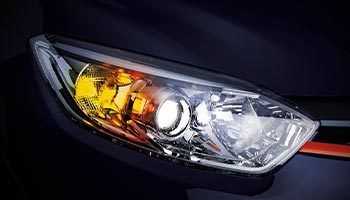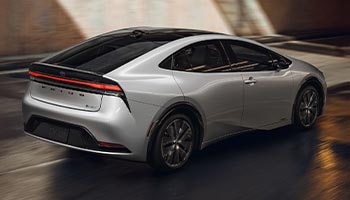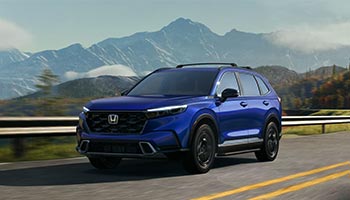If you’re old enough, you may remember when cars weren’t required to have seat belts. As technology in the auto industry advances, so do the standards we associate with vehicle safety. From rearview cameras to lane departure assist, many new car safety features are consistently highlighted on the year’s latest models. Today, consumers desire cars that are fuel-efficient, comfortable, and safe.
If you haven’t purchased a car within the last five years, there are likely plenty of safety features you aren’t aware of. However, understanding the latest advancements will help you along your search, especially if you’re upgrading from an older vehicle. Continue reading to learn more about the latest car safety features to look out for and some of the safest cars, according to the Insurance Institute for Highway Safety (IIHS).
Car Safety Features to Look For in a New Car

Car safety features like blind spot monitoring and rearview cameras have been standard on luxury cars for many years. However, as technology advances, many of these features have also been implanted in lower-priced models. In fact, regulators have even made rearview cameras a requirement on all cars manufactured after 2019. Although not all of the safety features listed below are mandated by law, there are plenty you should still prioritize when shopping for a new car.
Forward Collision Warning
One of the top safety features to have come out on the market is forward collision warning (FCW). As a vehicle equipped with FCW approaches a detected obstacle that could cause a forward collision, the car’s system issues an audible warning to alert the driver. FCW relies on cameras, lasers, and sensors to detect objects in front of your vehicle. Although the system should not replace a driver’s awareness of what is in front of them, an FCW can be beneficial in heavy traffic.
Blind Spot Monitoring
Regardless of how many windows you have, every car has blind spots. According to the National Highway Traffic Safety Administration (NHTSA), some 800,000 blind spot accidents occur yearly in the United States. Thankfully, however, blind spot monitoring has become a standard safety feature in new car models.
Blind spot monitoring will provide a visual alert if a vehicle travels alongside your car’s blind spot. Additionally, some systems may even have the ability to control your vehicle slightly and move you toward a safer distance. If you’re in the market for a larger truck or SUV, selecting a model with blind spot monitoring is a worthy purchase. Blind spot monitoring is not a replacement for checking your mirrors and blind spots before merging, but the added safety feature is helpful during highway travel.
Lane Keeping Assist
Distracted driving is the cause of many accidents on the road. When drivers aren’t paying attention, it’s possible to drift slightly into another vehicle’s lane, creating a hazardous situation. Going above typical lane departure warning systems, which alert you when you drift, lane-keeping assist systems can correct your steering wheel and nudge you back into your lane.
Although lane-keeping systems can manipulate your steering wheel, the force applied isn’t enough to overpower your own inputs. However, the system is designed to get your attention and correct any drifts before an accident occurs.
Adaptive Driving Beam Headlight Systems

Back in 2022, the NHTSA issued a final ruling that allows automakers to install adaptive driving beam headlights (ADB) on new vehicles. Adaptive headlight systems are designed to help drivers see clearer at night while reducing the glare for other motorists on the road.
Unlike older headlights, which remain fixed straight ahead, adaptive headlights have built-in technology that allows them to shine toward your steering direction. For example, some systems may slightly curve to the left when turning your vehicle left to help improve visibility. This technology can also help make you more visible on the road for other drivers.
Vehicles With High Safety Ratings to Consider
Okay, so you know what safety features to look for in a new car, but what are some vehicles with the highest safety ratings?
Each year, the Insurance Institute of Highway Safety (IIHS) releases its list of cars that meet their criteria for being a Top Safety Pick+. Top Safety Pick+ vehicles all have “good” ratings in the driver and passenger forward collision tests, as well as “good” ratings for the side collision tests (the highest rating possible). In addition, these vehicles also have “advanced” or “superior” ratings for daytime and nighttime vehicle-to-pedestrian front crash prevention. Below are just a few of the current year’s top picks.
Small Cars

- 2023-24 Toyota Prius
- 2023-24 Toyota Prius Prime
- 2023-24 Acura Integra
- 2024 Hyundai Elantra
- 2024 Mazda 3 Hatchback
- 2024 Mazda 3 Sedan
- 2024 Subaru Impreza Wagon
Midsize Cars
- 2023-24 Toyota Camry (built after 2023)
- 2023-24 Honda Accord
- 2023-24 Hyundai Ioniq 6
- 2023-24 Subaru Outback Wagon
SUVs (Small, Midsize, and Large)

- 2023-24 Honda CR-V
- 2023-24 Honda HR-V
- 2024 Hyundai Ioniq 5
- 2024 Kia Sportage
- 2023-24 Lexus RZ
- 2023-24 Jeep Grand Cherokee (Built after March 2023)
- 2023-24 Toyota Highlander
- 2024 Volkswagen Atlas Cross Sport
- 2023-24 Nissan Pathfinder
- 2024 Audi Q8 e-tron 4
Minivans
Large Pickups
Insuring Your Brand-New Car
Before heading off and purchasing your new car, it’s important that you speak with an insurance agent to understand how your current auto insurance policy may change.
Since you’ll be upgrading, you may need to add additional coverages to your policy depending on whether you finance or lease the new vehicle. Most lenders require comprehensive and collision coverage on financed or leased cars, which helps cover repair or replacement costs. If you’re not sure what to expect, our insurance specialists are always around to help. Give us a call today at (888) 772-4247, or start a free quote online to learn more.
The information in this article is obtained from various sources and is offered for educational purposes. Furthermore, it should not replace manuals or instructions provided by the manufacturer or the advice of a qualified professional. No warranty or appropriateness for a specific purpose is expressed or implied.


